Aloe vera has been grown in many countries worldwide for many years, and for good reason.
This plant may not look like much, but beneath the skin of its long, serrated, succulent leaves is an abundance of vitamins, minerals, and active compounds that provide numerous health benefits.
Aloe can be grown outside in temperate regions as a landscape plant or inside in cooler regions as a houseplant. As a succulent, it prefers a sandier, drier soil mixture and does not like to be wet.
But some plant enthusiasts are switching to hydroponic growing methods and would still like to have aloe as part of their indoor landscape.
Can aloe vera grow in water?
Aloe vera can be grown in water, but only temporarily. With adequate nutrition, sunlight, and the ideal temperature, this popular house plant can do very well in water until you pot it.
If you would like to grow aloe vera in water, you will find everything you need to know right here. Keep reading to find out more!
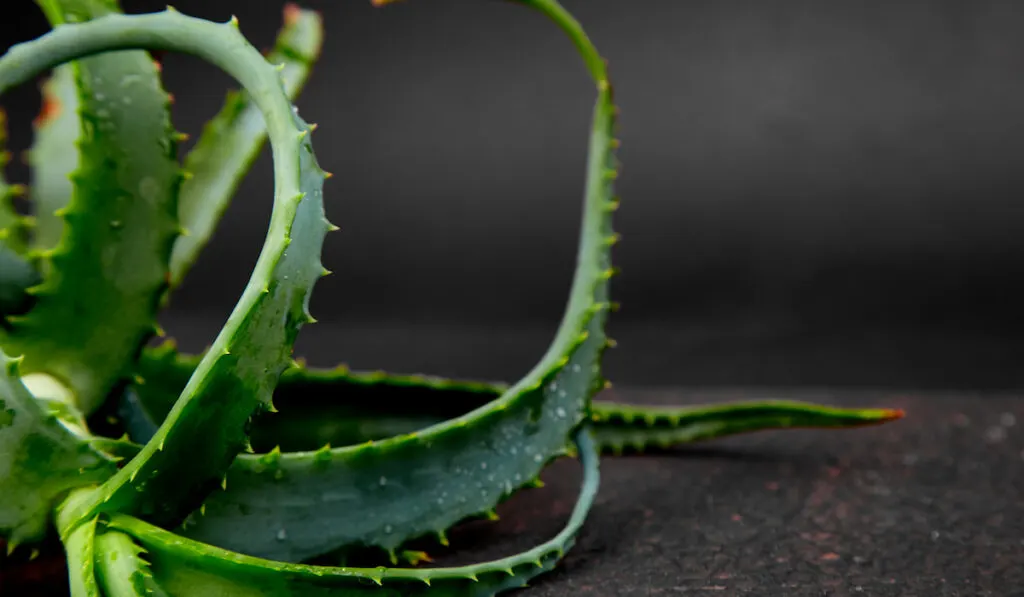
Table of Contents
Aloe Vera Overview
While aloe vera may be cactus-like in appearance, it is not part of the cactus family. It actually belongs to the Asphodelaceae family.
It is grown in the southern borderlands of Texas, New Mexico, Arizona, California, and other subtropical locations worldwide.
Aloe vera got its name from both Arabic and Latin origins. “Alloeh” means “shining bitter material” in Arabic, and “vera” originated from the Latin word “vera,” meaning “truth.”
This unique plant has long been used in various civilizations, including in Egypt, Greece, Mexico, India, China, and Japan. The plant grows well in arid areas of Asia, Europe, America, and Africa.
Aloe Vera Appearance
Despite its short stem, this plant has long, thick leaves reaching up to 39 inches long. While young, the succulent leaves are green with white spots and have serrated edges.
It may surprise you to learn that when aloe vera is grown in a natural environment, a tall stem-like spike grows from the plant’s center, adorned with yellowish-green flowers.
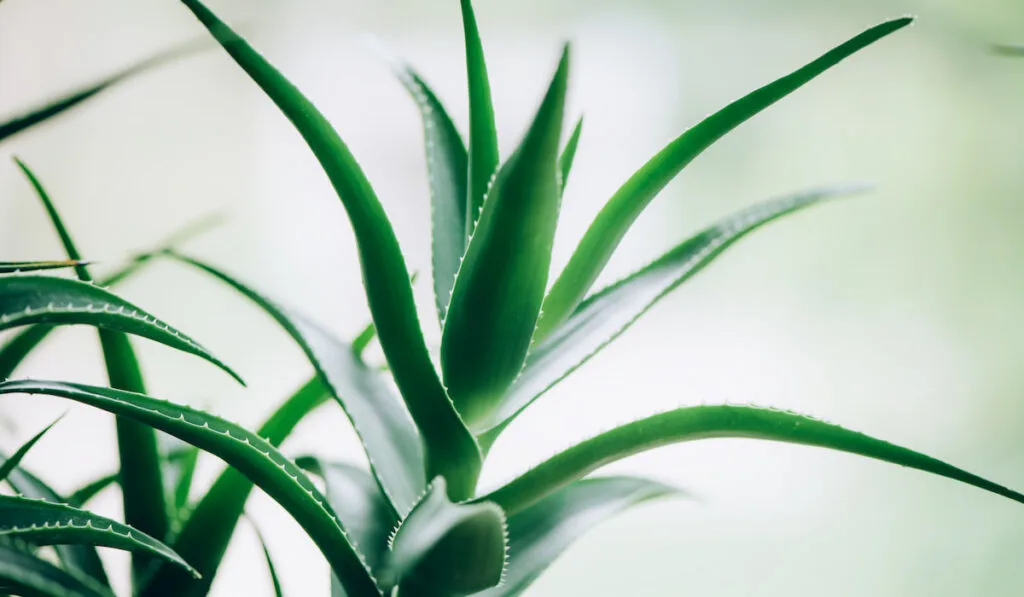
What Does Aloe Vera Contain?
Aloe vera includes several vitamins, minerals, and active compounds that provide numerous health benefits.
This plant’s leaves have an exterior green skin, a layer of latex, and the mesophyll layer, known as the “gel.” This gel retains water, allowing the plant to photosynthesize during drought.
- The outer layer of skin comprises 15 to 20 cells. It protects the leaf’s interior section while synthesizing proteins and carbs.
- The middle layer comprises latex, a yellow sap rich in glycosides and anthraquinones.
- Aloe vera gel contains 99% water and a range of amino acids, enzymes, minerals, lipids, vitamins, and anti-inflammatory hormones.
Benefits of Aloe Vera
Aloe vera has 420 different plant species and is often used for its beauty, health, skincare, and medical characteristics.
It is common in traditional and natural therapeutic practices all over the globe.

Vitamins
The antioxidant vitamins A, C, and E attack and destroy free radicals.
Aloe vera also includes vitamins B1, B2, B6, and B12, aiding detoxification.
Vitamin A:
- Aids in forming and maintaining healthy teeth, skeletal and soft tissue, mucus membranes, and skin.
- It is also responsible for the pigments seen in the eye’s retina. Improves eyesight, particularly in low light.
- It is important for a healthy pregnancy and breastfeeding.
Vitamin C:
- It increases antioxidant levels.
- It decreases blood pressure.
- It prevents gout episodes.
- It enhances iron absorption.
- It boosts immunity.
- It lowers the risk of heart disease, dementia, and premature aging.
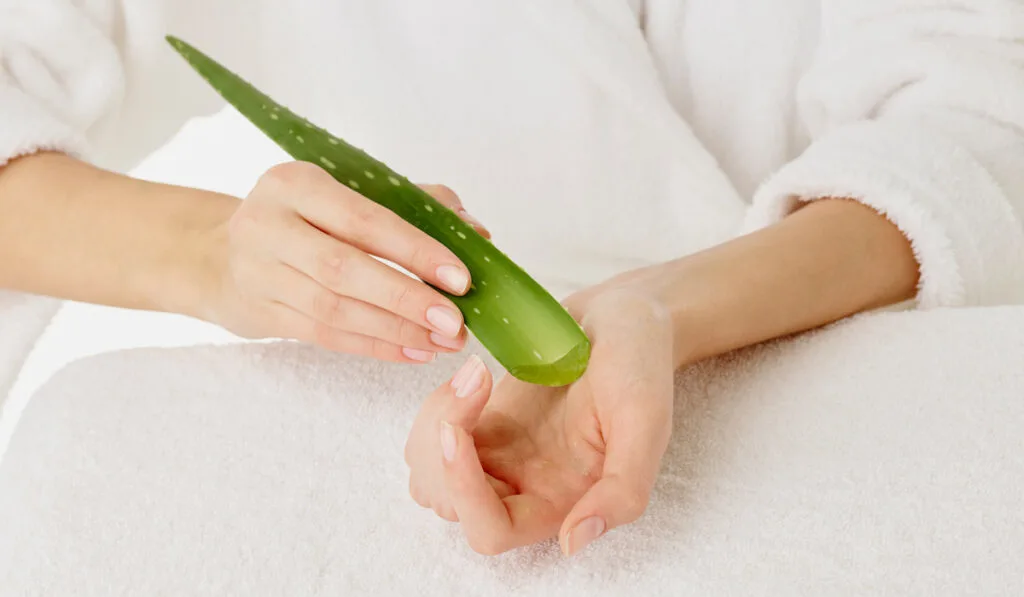
Vitamin E:
- It helps maintain healthy skin and eyes.
- It strengthens the immune system to fight against illness and infection.
- It aids in the health of your blood, brain, and skin.
- It has antioxidant properties.
Vitamin B1:
- It helps protect the nervous system, brain, muscles, heart, stomach, and intestines against difficulties.
- It boosts the immune system and increases the body’s capacity to resist stressful situations.
Vitamin B2:
- It helps to minimize oxidative stress and nerve inflammation.
Vitamin B6:
- It promotes brain development.
- It helps the neurological and immune systems to function.
Vitamin B12:
- It helps develop red blood cells, cell metabolism, and neuron function.
- It aids in the creation of DNA.
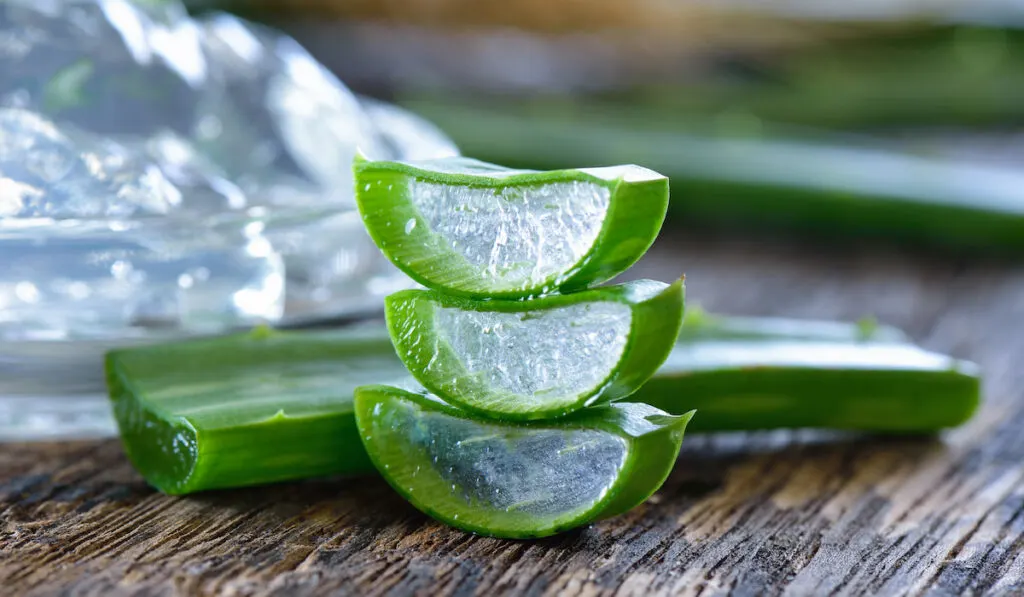
Monosaccharides and Polysaccharides
Aloe vera contains monosaccharides and polysaccharides with antiviral, anti-mycotic, antibacterial, and anti-inflammatory effects. Plus, they also stimulate the immune system.
They include:
- Aldopentose
- Cellulose
- Galactose
- Arabinose
- Galacturonic acid
- Glucose
- Mannose
- Xylose
Enzymes
Aloe vera has several enzymes that help reduce inflammation of the skin. These include:
- Amylase
- Bradykinase
- Aliases
- Alkaline
- Phosphatase
- Peroxidase
- Catalase
- Cellulose
- Lipase
- Carboxypeptidase
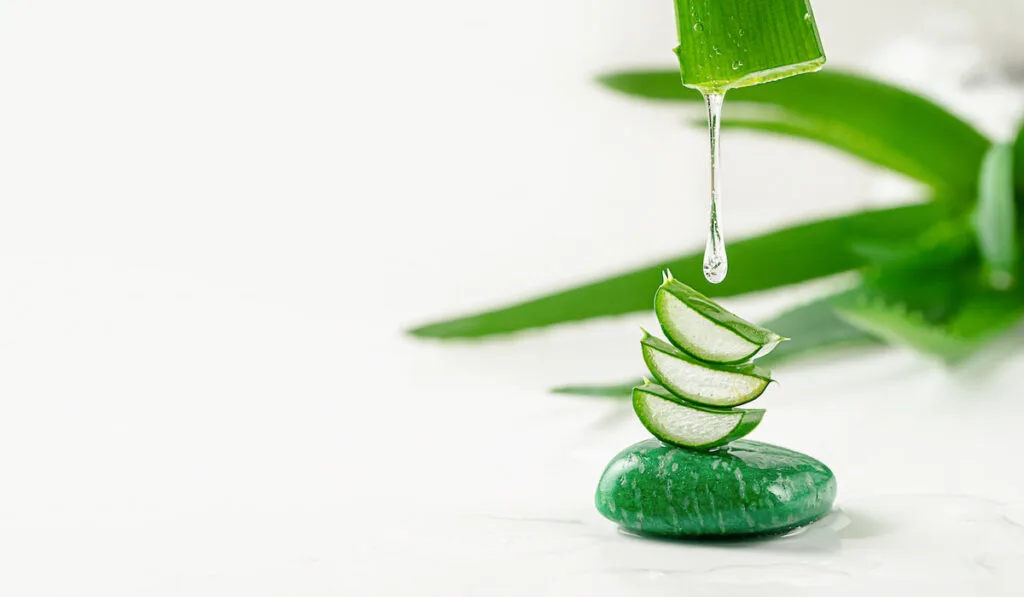
Hormones
Hormones are found in aloe vera and promote more effective wound healing. They are also effective in reducing inflammation.
They include:
- Gibberellins
- Auxins
Aloe vera is used to promote the healing of many skin conditions, including:
- Acne
- Burning mouth
- Insect bites
- Skin damage
- Mild burns
- Diaper rash
- Wound healing
- Itchy skin
- Sunburn
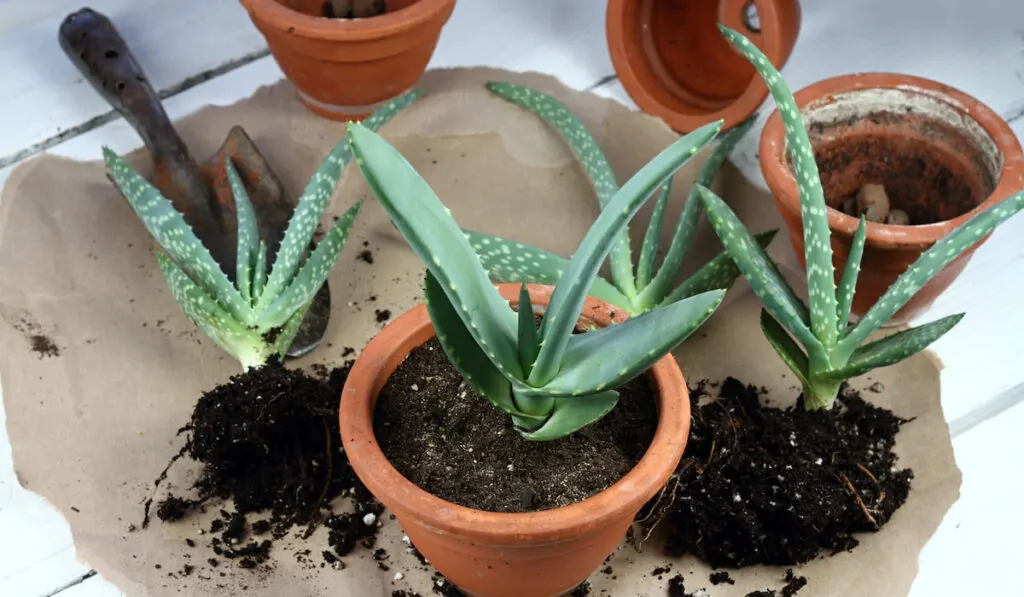
How to Care for Aloe Vera?
Aloe vera is the perfect plant for beginners. And with proper care, an indoor aloe plant can live up to 12 years.
Aloe plants thrive in well-drained soil, but it’s best not to use garden soil. Commercial potting mixes are a better option, or you could create your own by combining equal parts sand, peat moss, and perlite.
Terra Cotta Works Best
Your aloe plant will have fewer complications if you use a porous pot like terra cotta. While plastic pots can work, porous pots prevent waterlogging and keep the soil dry.
Aloes don’t need much fertilizer. Apply a basic houseplant fertilizer or a fertilizer made specifically for succulents and cacti at the beginning of spring when new growth starts. Follow instructions carefully.

Aloes Love Indirect Sunlight
Bright, indirect sunshine is ideal for aloe plants. Set them in a window with plenty of indirect sunlight for the best results.
If you wish to grow an aloe plant outside, it’s best to do so from its beginning and in full sunlight. Don’t relocate from indoors to outdoors, as the plant may suffer sunburn.
Grow lights are an option for those who don’t have access to enough natural light. But give your plants a break from the artificial light occasionally.
Temperature
Aloe plants thrive in a warm environment, so you should aim for temperatures between 55°F and 85°F (12.7°C and 29.4°C). Aloe leaves will turn yellow or wilt if it gets too chilly.
Being sensitive to drafts, these plants should not be placed near a door or window that is opened and closed too often.
Watering
Because they are succulents, aloe plants need very little water. Overwatering may lead to rot.
While watering it once a week should be plenty, it may require watering twice weekly if positioned in a hot, dry space. Only water when the soil has totally dried up.
Be sure to give your aloe plant a generous amount of water every time you do water it.

Growing Aloe Vera in Water
Aloe vera can be grown in water, but only temporarily. This plant will do better if it is permanently planted in soil.
If you’re short on time but still want to care for your aloe, it should survive for a few weeks in water alone.
How to Successfully Grow Your Aloe Vera in Water
- Removing any dirt from the aloe plant’s roots is important before you can start growing it. Remember that aloe plants’ roots are easily damaged, so handle them with care.
- Untangle the roots before lifting the younglings away from the mother plant. Check that each youngling has some roots.
- Place the aloe youngling in a bulb vase half-filled with filtered or distilled water. You want the roots to be partly submerged—leave some exposed to the air so they may absorb oxygen as well.
- Regularly replacing the water in the vase is essential for maintaining a healthy aloe plant. This renews the aloe’s nutrient supply and keeps it algae-free.
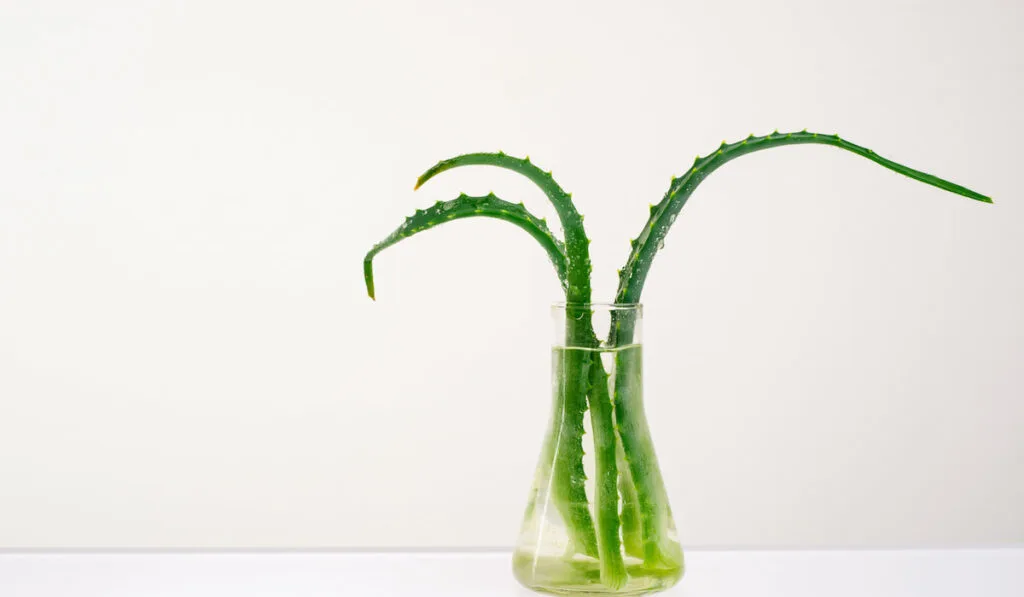
Caring for Aloe Vera Grown in Water
Lighting that is both bright and indirect is ideal for aloe plants.
By placing them close to an east or south-facing window, there will be plenty of sunshine, but it won’t be strong enough to scorch their succulent leaves.
For your plant to thrive in water, oxygen is essential.
While aloe vera plant creates oxygen through photosynthesis, its roots don’t. To combat this problem, simply leave an inch or so of the roots exposed to the air above the water’s surface.
Adding some liquid fertilizer to the water will encourage your plants’ growth. Add half the recommended dose of hydroponic fertilizer to the water, as too much could result in nitrogen burn.
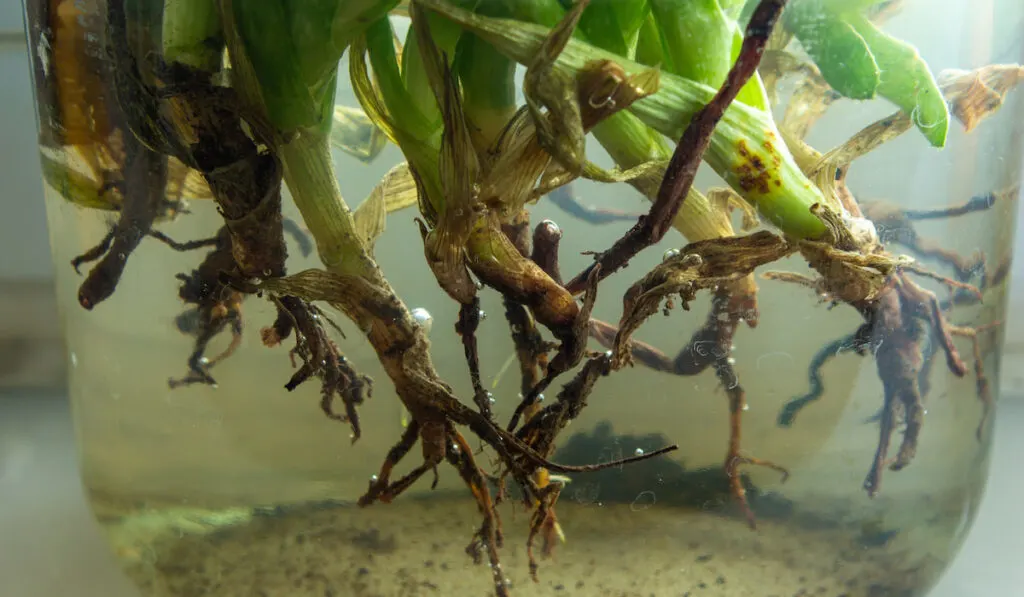
Why Do the Leaves and Roots of Aloe Turn Brown or Yellow?
If your aloe’s leaves or roots begin to turn yellow or brown, it’s time to transplant it to a container of soil, so it doesn’t die. There are several reasons why your plant could be dying.
- Your aloe vera is not getting enough sunlight or possibly getting too much sunlight.
- The roots of your plant are completely covered with water.
- The water needs changing.
- Your plant is too close to a heater or A/C vent.
- You have positioned your aloe in a room that is too drafty.
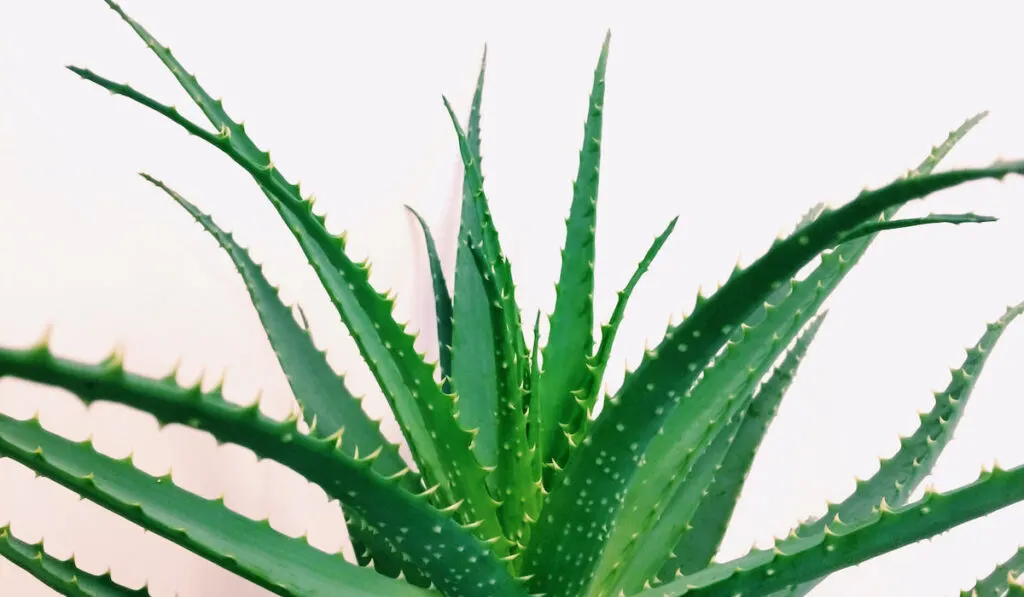
Issues With Algae
Algae is a common problem when growing an aloe plant in water. If your water turns green, get rid of the polluted water and use soap and water to clean the vase.
Refill with clean water and reposition your plant, ensuring the roots are partially exposed to the air.
As light and heat are the primary factors when algae is a problem, move your vase to a cooler location or place it in the shadow of another object.
Final Thoughts
Aloe vera is an amazing plant packed with vitamins and minerals. From insect bites to sunburn, this plant has the healing properties necessary to soothe skin issues and promote healing.
To successfully grow aloe vera in water, you must pay attention to certain guidelines. For example, you must prepare your plant in the correct container with adequate water and oxygen.
Sunlight, nutrition, and temperature are also important factors for your plant to remain healthy.
Resources
- https://www.nccih.nih.gov/health/aloe-vera
- https://www.news-medical.net/health/What-is-Aloe-Vera.aspx
- https://gardenerspath.com/plants/succulents/grow-aloe-vera/
- https://www.architecturaldigest.com/reviews/home-products/how-to-take-care-of-an-aloe-plant
- https://gardenforindoor.com/how-to-grow-aloe-vera-in-water/
- https://www.petalrepublic.com/can-aloe-plants-grow-in-water/
